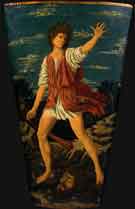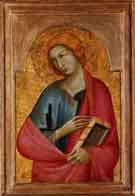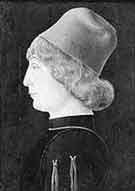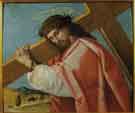|
|
 |
 |

|
A fine art collection is practically
synonymous with the English country house, and Locko has been no
exception. Painting acquired on 'grand tours' of Europe have hung in
the picture galleries alongside portraits of ancestors. And (as is
so often the case with these collections) key works have been sold
as new owners succeeded to the estate, driven by differing artistic
taste or simple financial necessity.
A key figure behind the arts
acquisitions of Locko was William
Drury Lowe (1803-1877). Between 1840 and 1865 he acquired over 300 works, many
during his European travels. Key works acquired were those often
referred to as 'Italian primitives'. These are works from blah blah
blah.
William Drury Lowe's eldest son, William Nathanial Drury
Lowe, succeeded to the estate in 1877. He shared his father's love
of art, and commissioned Italianate painted ceilings
in the galleries to complement the paintings.
His eldest son, William Drury Lowe,
sold twelve paintings, including some of those seen as the most
important in the collection (see Portrait of Duke Ercole of Ferrara,
below). Other works have since been auctioned, but the collection
still represents a significant contribution to the study of Italian
'primitive' art.
As the house is not open to the
public, the paintings are, sadly, not available for viewing. The
collection has been documented a number of times over the years, by
Dr. Waagan in 1857, and by Dr. J P Richter in 1901 (commissioned by
William Nathanial Drury-Lowe).
An exhibition of notable works from the collection was held in 1968,
at the Nottingham University Art Gallery.
The Locko
Collection has included works by Andrea del Castago, Canaletto, de Momper, Paul Bril,
Daniel Mytens, Arthur Devis and Joseph
Wright.
|
The Youthful David, Andrea del Castago
Brought to Locko by William Drury Lowe, this
is now exhibited at the National Gallery of Art in Washington DC, USA. The
work is a painted parade shield, a true rarity. Note the curved shape (see
illustration, top right).A feature
of early Italian art was to present a whole story within the picture rather
than a 'snap-shot' of the action - David's sling is loaded and ready,
but Goliath's head already lies at David's feet.
Two points of note - artists in
Florence often painted images of David as the city itself saw itself as a
David up against the Goliaths of Milan and Venice, and the idea of God being
David's shield is recorded in the Book of Psalms.
Duke Ercole of Ferrara, Cosimo
Tura
Originally ascribed to Piero della
Francesca, now attributed to Cosimo di Domenico di Bonaventura. Most likely
to have been cut down from a larger work.
Antwerp,
Joos de Momper

Formerly attributed to Jan Brughel, this
harvesting scene is in the great landscape tradition of Pieter Brughel the
Elder.
|
 |
|
Key Works |
|
|
|
The Youthful David, Andrea del Castago |
|
|
 |
|
|
|
National Gallery of Art,
Washington, USA
www.nga.gov |
|
|
|
Saint John the Evangelist,
Sienese School, 14th C |
| |
 |
| |
| |
|
Duke Ercole of Ferrara,
Cosimo Tura |
| |
|
 |
| |
|
Metropolitan Museum
of Art, USA
www.metmuseum.org |
| |
|
Christ carrying
the cross,
Francesco Bacchiacca |
| |
|
 |
| |
|
|
|
|
St. Catherine of
Alexandria,
Bernado Daddi |
|
|
 |
| |
|
| |
|
|